1971 CHEVROLET CAMARO recommended oil
[x] Cancel search: recommended oilPage 13 of 88
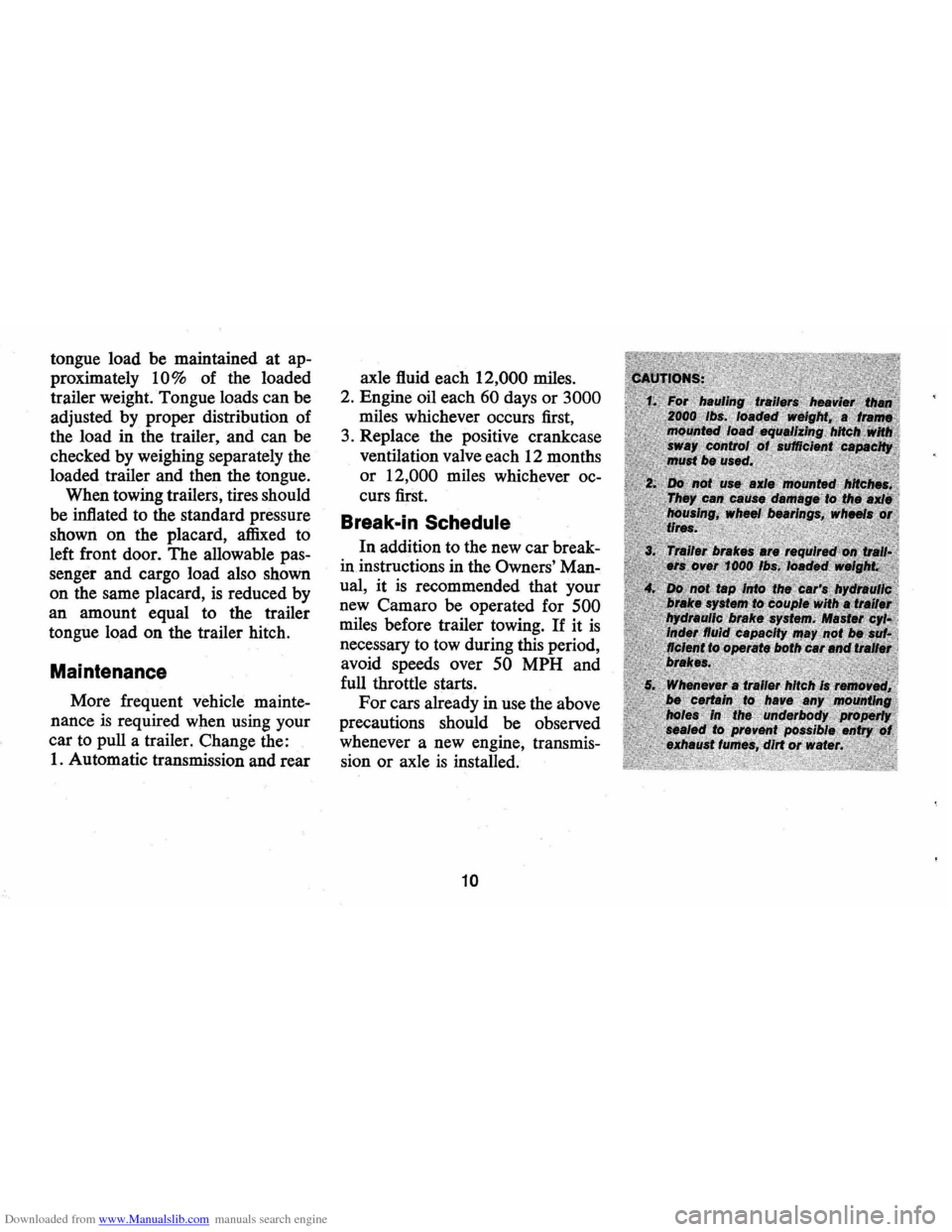
Downloaded from www.Manualslib.com manuals search engine tongue load be maintained at ap
proximately
10% of the loaded
trailer weight. Tongue loads can be
adjusted by proper distribution of
the load in the trailer, and can be
checked by weighing separately the
loaded trailer and then the tongue.
When towing trailers, tires should
be inflated to the standard pressure
shown
on the placard, affixed to
left front door. The allowable pas
senger and cargo load also shown
on the same placard,
is reduced by
an amount equal to the trailer
tongue load on the trailer hitch.
Maintenance
More frequent vehicle mainte
nance
is required when using your
car to pull a trailer. Change the:
1. Automatic transmission and rear axle
fluid each
12,000 miles.
2. Engine oil each
60 days or 3000
miles whichever occurs first,
3. Replace the positive crankcase
ventilation valve each 12 months
or 12,000 miles whichever oc
curs first.
Break .. in Schedule
In addition to the new car break
in instructions in the
Owners' Man
ual,
it is recommended that your
new Camaro be operated for
500
miles before trailer towing. If it is
necessary to tow during this period,
avoid speeds over
50 MPH and
full throttle starts.
For cars already in use the above
precautions should be observed
whenever a new engine, transmis
sion
or axle is installed.
10
Page 30 of 88

Downloaded from www.Manualslib.com manuals search engine "
Selector (Upper Lever)
This lever provides a selection of
systems available to handle various
heating and cooling requirements
throughout the year. The positions
of the Selector lever are separated
into four (4) major operational
groups
"Off", IIAir Conditioning",
IIVent" and IIHeating". The "Air
Conditioning" and IIHeating"
groups have several positions which
improve the effectiveness of
the
system for various demands.
Fan
The fan lever has four (4) posi
tions from Lo at the top to High at
the bottom. Blower speed
is auto
matically maintained when the
ignition switch
is in the "ON" posi
tion, regardless of the position of
the selector lever. The blower re
mains
ON with the Selector lever
in the
OFF position and the igni
tion switch
ON in order to purge moisture
from the evaporator core
and distributor ducts, thereby help
ing to prevent inadvertent flash
fogging of the windows when the
system
is turned on.
Selector Lever Operation
uOFF" -Shuts the entire system off
but blower automatically remains
operative.
uMAX"-Air from the passenger
compartment is recirculated
through the system and discharged
from the upper outlets when the
temperature lever
is in "Max." cold.
(If the liTem perature" lever is
moved warmer, the system will
automatically
go on outside air.)
The
IIMax." position is used when
maximum cooling
is required under
conditions of high temperature and
humidity.
uNORMAL" -Outside air is passed
through the system and discharged
through the
Ale outlets. This posi-
27
tion is recommended for most air
conditioning situations because of
reduced blower noise and reduction
of cigarette smoke within the
ve
hicle.
uBI-LEVEL"-Outside air is passed
through the system and discharged
from both the upper and lower out
lets. This position
is recommended
for sunny cooler weather where
warm air
is required on the feet
with cooler air above to provide
comfortable breath level. Temper
ature may be adjusted
as desired.
(<> BI-Level position)
NOTE: This position will clear
fogged windows rapidly due to the
dehumidifying effect of the cooling
coils when the outside temperature
is above 30°F.
UVENT" -Air flow and tempera
ture control are the same
as "BI
Level"
except that the compressor
Page 47 of 88
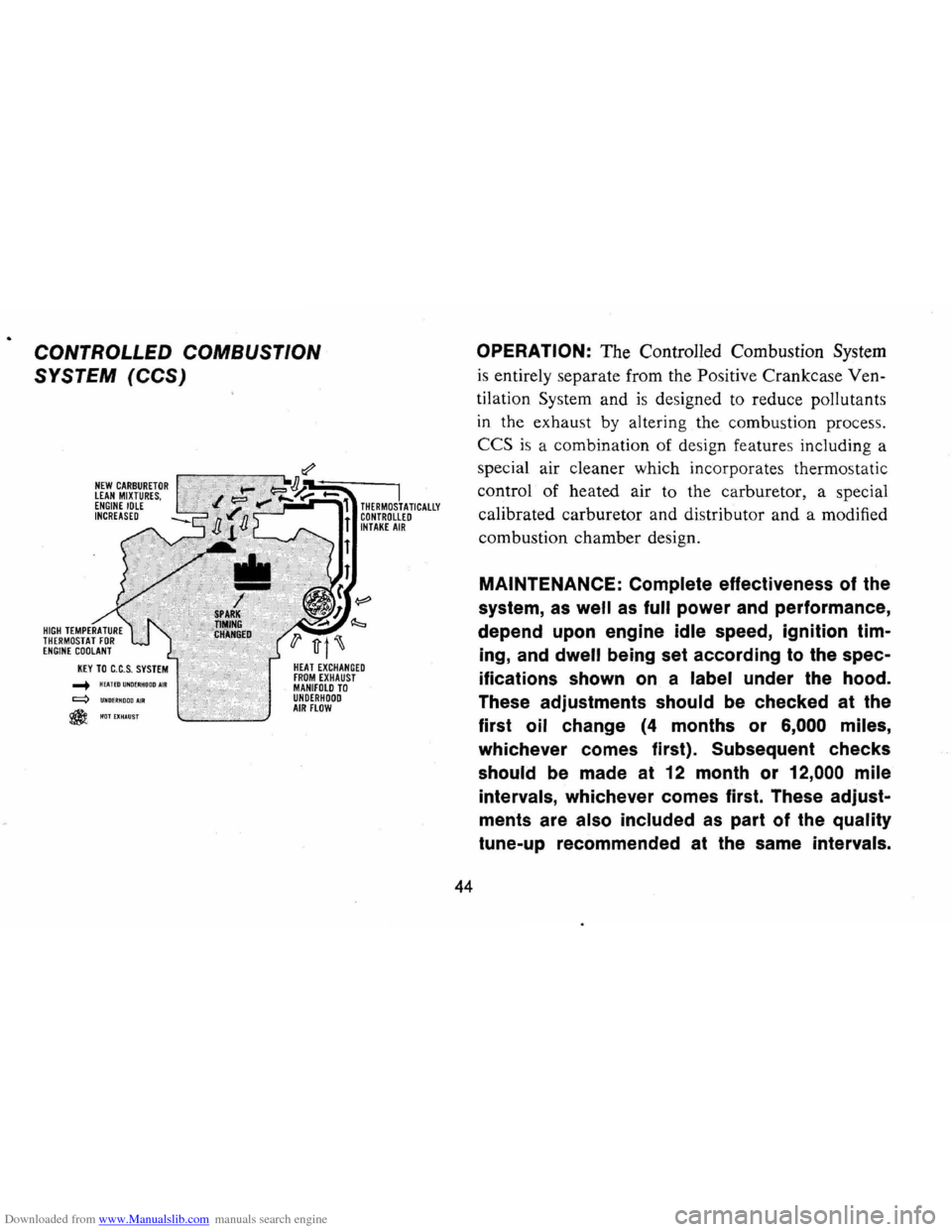
Downloaded from www.Manualslib.com manuals search engine CONTROLLED COMBUSTION
SYSTEM
(CCS)
NEW CARBURETOR LEAN MIXTURES, ENGINE IDLE INCREASED
..... HEAlEDUNDEIiHODDAIR q UND£RHOODAJR
@HOTEXHAUST
I THERMOSTATICALLY CONTROLLED INTAKE AIR
HEAT EXCHANGED FROM EXHAUST MANIFOLD TO UNDERHOOD AIR FLOW
44
OPERATION: The Controlled Combustion System
is entirely separate from the Positive Crankcase Ven
tilation
Sys tem and is designed to reduce pollutants
in the exhau st by altering the combustion process,
CCS is a combination of design features including a
special air cleaner which incorporates thermostatic
control of heated air to the carburetor, a special
calibrated carburetor and distributor and a modified
combustion chamber design,
MAINTENANCE: Complete effectiveness of the
system,
as well as full power and performance,
depend
upon engine idle speed, ignition tim
ing,
and dwell being set according to the spec
ifications
shown on a label under the hood.
These adjustments should be checked at the
first oil change
(4 months or 6,000 miles,
whichever comes first). Subsequent checks
should be made at
12 month or 12,000 mile
intervals, whichever comes first. These adjust
ments are also included
as part of the quality
tune-up recommended at
the same intervals.
Page 48 of 88
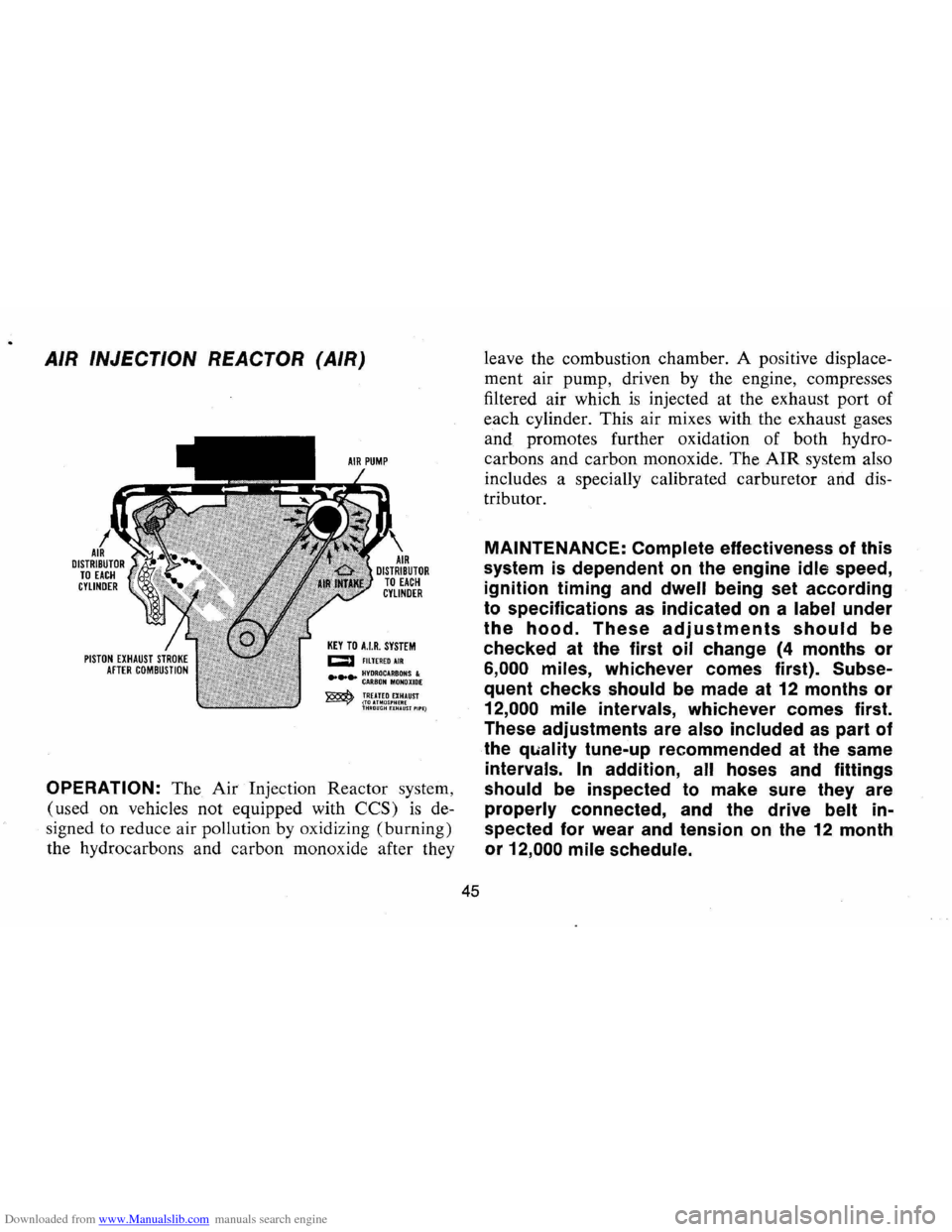
Downloaded from www.Manualslib.com manuals search engine AIR INJECTION REACTOR (AIR)
KEY TO HR. SYSTEM CJ F1LTEREDAIR
.... ~!~:~~A:~~~~I:E ~ TREATED EXHAUST ~(TOUMOS'HERE THMOUGHHHAlIST'II'E)
OPERATION: The Air Injection Reactor system,
(used on vehicles not equipped with
CCS) is de
signed to reduce air pollution by oxidizing (burning)
the hydrocarbons and carbon monoxide after they
45
leave the combustion chamber. A positive displace
ment air pump, driven by the engine, compresses
filtered air which
is injected at the exhaust port of
each cylinder. This air mixes with the exhaust gases
and promotes further oxidation of both hydro
carbons and carbon monoxide. The
AIR system also
includes a specially calibrated carburetor and dis
tributor.
MAINTENANCE: Complete effectiveness of this
system
is dependent on the engine idle speed,
ignition timing and
dwell being set according
to specifications as indicated on a label under
the hood. These adjustments should be
checked at the first oil change (4 months or
6,000 miles, whichever comes first). Subse
quent checks should be made at 12 months or
12,000 mile intervals, whichever comes first.
These adjustments are
also included as part of
the
quality tune-up recommended at the same
intervals. In addition, all hoses and fittings
should be inspected to make sure they are
properly connected, and the drive belt in
spected for wear
and tension on the 12 month
or
12,000 mile schedule.
Page 52 of 88

Downloaded from www.Manualslib.com manuals search engine Fruit Stains, Coffee, Soft Drinks,
Ice Cream and Milk-Wipe with
cloth soaked in cold water.
If nec
essary clean lightly with fabric
cleaning fluid.
Soap and water is
not recommended as it might set
the stain.
Catsup-Wipe with cloth soaked in
cool water.
If further cleaning is
necessary, use a detergent foam
cleaner.
Grease, Oil, Butter, Margarine
and Crayon -
Scrape off excess
with dull knife.
Use fabric cleaning
fluid.
Exterior Appearance
Your car is finished with General
Motors "Magic-Mirror" acrylic
lacquer. This is a finish of maxi
mum beauty which, in depth of
color, gloss retention and durability
is superior to conventional lacquer
finishes.
Paste or Wax Type Shoe Polish
-Light applications of fabric clean
ing fluid.
Tar -Remove excess with dull
knife, moisten with fabric cleaning
fluid, scrape again, rub lightly with
additional cleaner.
Blood -Wipe with clean cloth
moistened with cold water. Use no
soap.
Urine -Sponge stain with luke
warm soap suds from mild neutral
soap on clean cloth, rinse with cloth
Washing Your Car
The best way to preserve the
finish and maintain original beauty
of appearance
is to keep it clean .
Wash the car in lukewarm
or cold
water. Never use strong soap or
chemical detergents. Cleaning
agents should be quickly flushed
from the surfaces.
49
soaked in cold water, saturate cloth
with one part household ammonia
and 5 parts water, apply for 1 min
ute, rinse with
clean, wet cloth.
Vomitus-Sponge with clean cloth
dipped in clean, cold water. Wash
lightly with lukewarm water and
mild neutral soap.
If odor persists,
treat area with a water-baking soda
solution (1 teaspoon baking soda
to one cup of tepid water). Rub
again with cloth and cold water.
Finally,
if necessary, clean lightly
with fabric cleaning fluid.
Polishing and Waxing
Your Car
Although acrylic paint on your
car
is durable, you may wish to wax
or polish for added protection.
Your Chevrolet Dealer offers many
polishes and waxes now available
which have proven of real value in
maintaining a good paint finish.
Page 53 of 88
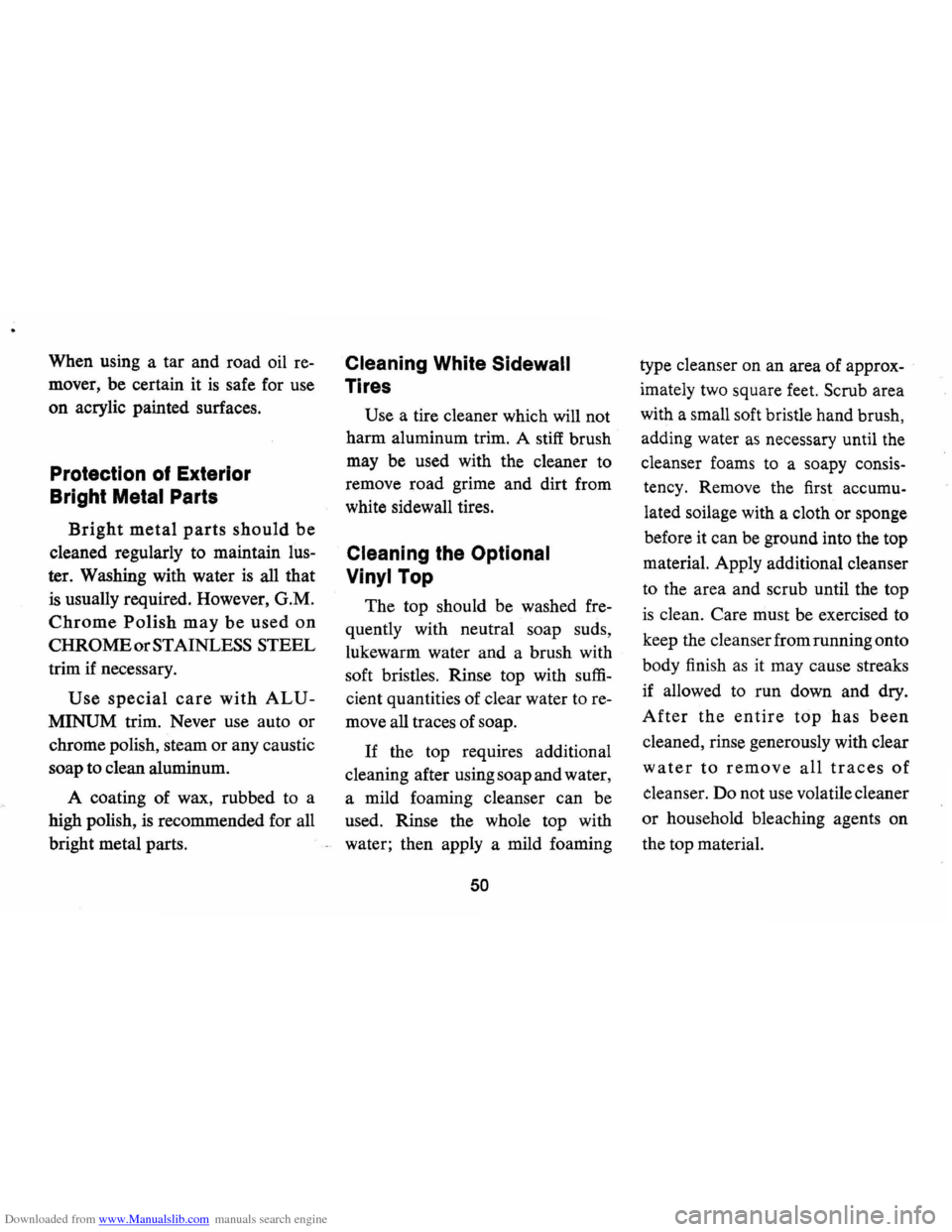
Downloaded from www.Manualslib.com manuals search engine When using a tar and road oil re
mover, be certain it
is safe for use
on acrylic painted surfaces.
Protection of Exterior
Bright
Metal Parts
Bright metal parts should be
cleaned regularly to maintain lus
ter. Washing with water
is all that
is usually required. However, G.M.
Chrome Polish may be used on
CHROMEorSTAINLESS STEEL
trim
if necessary.
Use special care with ALU
MINUM trim. Never use auto or
chrome polish, steam or any caustic
soap to clean aluminum.
A coating of wax, rubbed to a
high polish,
is recommended for all
bright metal parts.
Cleaning White Sidewall
Tires
Use a tire cleaner which will not
harm aluminum trim. A
stiff brush
may be used with the cleaner to
remove road grime and dirt from
white sidewall tires.
Cleaning the Optional
Vinyl
Top
The top should be washed fre
quently with neutral soap suds,
lukewarm water and a brush with
soft bristles. Rinse top with
suffi
cient quantities of clear water to re
move all traces of soap.
If the top requires additional
cleaning after using soap and water,
a mild foaming cleanser can be
used. Rinse the whole top with
water; then apply a mild foaming
50
type cleanser on an area of approx
imately two square feet. Scrub area
with a small soft bristle hand brush,
adding water
as necessary until the
cleanser foams
to a soapy consis
tency. Remove the first accumu
lated soilage with a cloth or sponge
before it can be ground into the top
material. Apply additional cleanser
to the area and scrub until the top
is clean. Care must be exercised to
keep the cleanser from running onto
body finish
as it may cause streaks
if allowed to run down and dry.
After the entire top has been
cleaned , rinse generously with clear
water to remove all traces of
cleanser. Do not use volatile cleaner
or household bleaching agents on
the top material.
Page 55 of 88
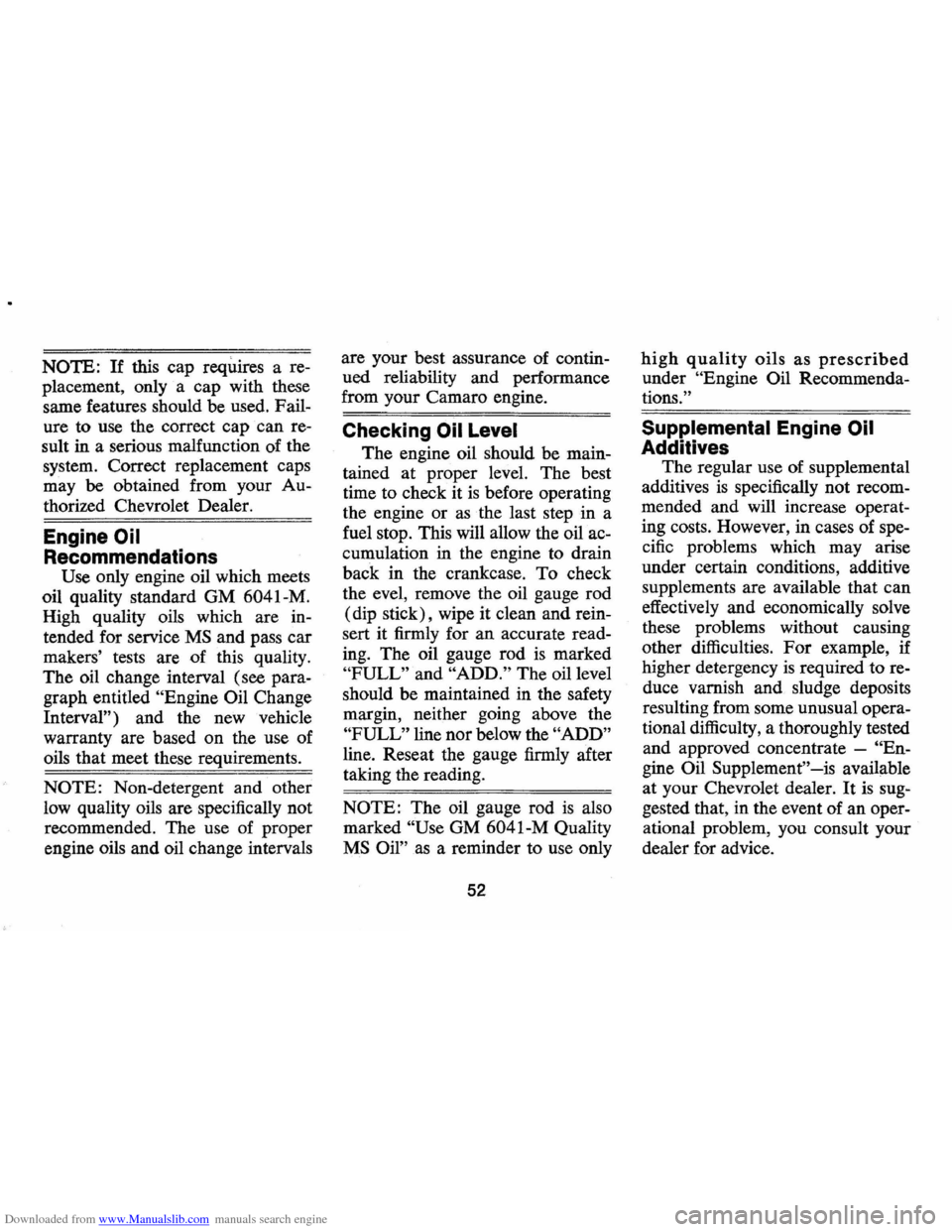
Downloaded from www.Manualslib.com manuals search engine NOTE: If this cap requires a re
placement, only· a cap with these
same features should be used. Fail
ure to use the correct cap can re
sult in a serious malfunction of the
system. Correct replacement caps
may
be obtained from your Au
thorized Chevrolet Dealer.
Engine Oil
Recommendations
Use only engine oil which meets
oil quality standard GM 6041-M.
High quality oils which are in
tended for service
MS and pass car
makers' tests are
of this quality.
The oil change interval (see para
graph entitled
"Engine Oil Change
Interval") and the new vehicle
warranty are based on the use of
oils that meet these requirements.
NOTE: Non-detergent and other
low quality oils are specifically not
recommended. The use of proper
engine oils and oil change intervals are
your best assurance of contin
ued reliability and performance
from your Camaro engine.
Checking Oil Level
The engine oil should be main
tained at proper level. The best
time to check it
is before operating
the engine or as
the last step in a
fuel stop. This will allow the oil ac
cumulation in the engine to drain
back in the crankcase .
To check
the evel, remove the oil gauge rod
(dip stick), wipe it clean and rein
sert it firmly for an accurate read
ing. The oil gauge rod
is marked
"FULL" and "ADD." The oil level
should be maintained in the safety
margin, neither going above the
"FULL" line nor below the "ADD"
line. Reseat the gauge firmly after
taking the reading.
NOTE: The oil gauge rod is also
marked
"Use GM 6041-M Quality
MS Oil" as a reminder to use only
52
high quality oils as prescribed
under "Engine Oil Recommenda
tions."
Supplemental Engine Oil
Additives
The regular use of supplemental
additives
is specifically not recom
mended and will increase operat
ing costs. However, in cases of spe
cific problems which may arise
under certain conditions, additive
supplements are available that can
effectively and economically solve
these problems without causing
other difficulties.
For example, if
higher detergency
is required to re
duce varnish and sludge deposits
resulting from some unusual opera
tional difficulty, a thoroughly tested
and approved concentrate -
"En
gine Oil Supplement"-is available
at your Chevrolet dealer.
It is sug
gested that, in the event of
an oper
ational problem, you consult your
dealer for advice.
Page 56 of 88
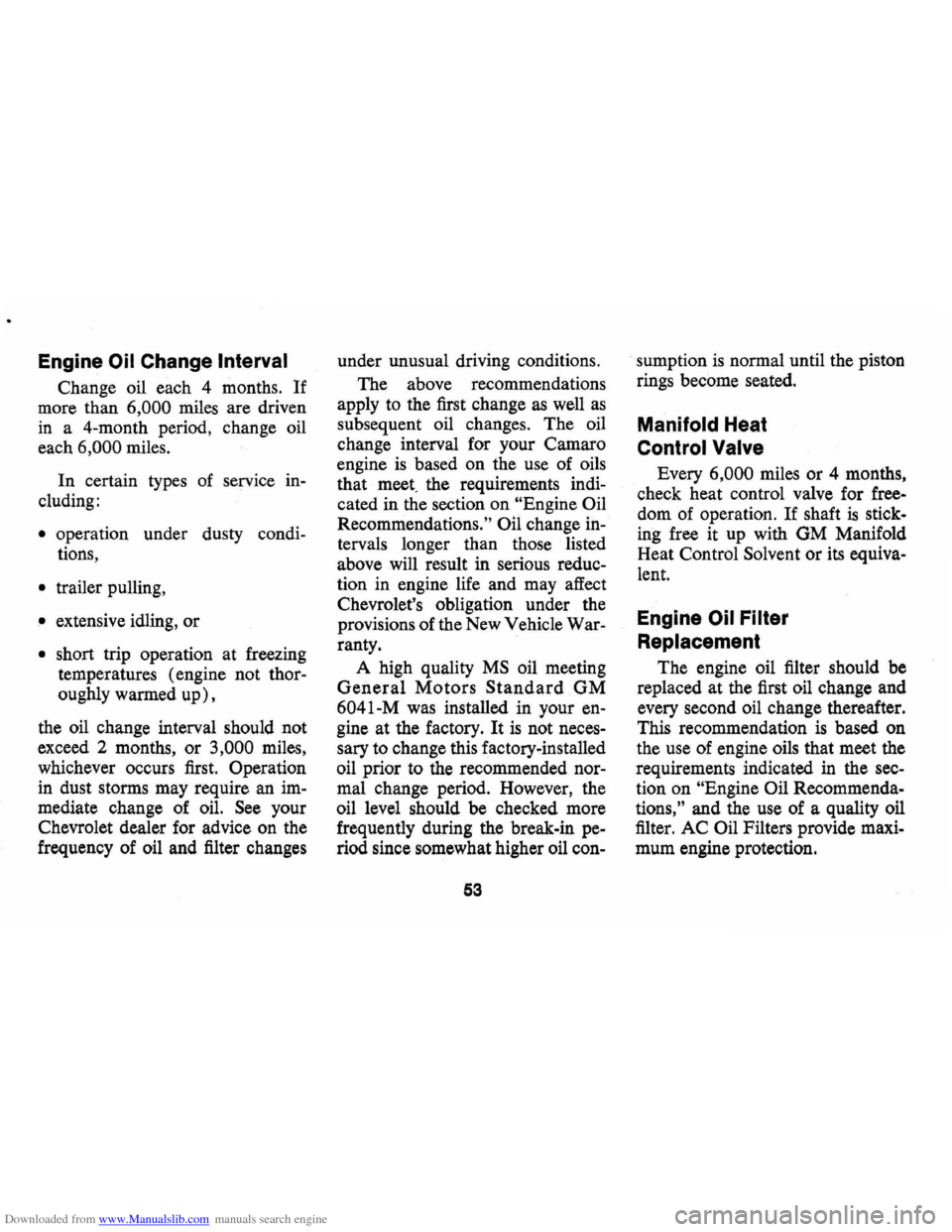
Downloaded from www.Manualslib.com manuals search engine Engine Oil Change Interval
Change oil each 4 months. If
more than 6,000 miles are driven
in a 4-month period, change oil
each
6,000 miles.
In certain types of service in
cluding:
• operation under dusty condi
tions,
• trailer pulling,
• extensive idling, or
• short trip operation at freezing
temperatures (engine not
thor
oughly warmed up),
the oil change interval should not
exceed 2 months, or
3,000 miles,
whichever occurs
first. Operation
in dust storms may require an im
mediate change of oil. See your
Chevrolet dealer for advice on the
frequency of oil and filter changes under
unusual driving conditions.
The above recommendations
apply to the first change
as well as
subsequent oil changes. The oil
change interval for your Camaro
engine
is based on the use of oils
that
meet. the requirements indi
cated in the section on "Engine Oil
Recommendations." Oil change in
tervals longer than those listed
above will result in serious
reduc
tion in engine life and may affect
Chevrolet's obligation under the
provisions of the
New Vehicle War
ranty.
A high quality
MS oil meeting
General Motors Standard GM
6041-M was installed in your en
gine at the factory. It is not neces
sary to change this factory-installed
oil prior to the recommended
nor
mal change period. However, the
oil level should
be checked more
frequently during the break-in pe
riod since somewhat higher oil con-
53
sumption is normal until the piston
rings become seated.
Manifold Heat
Control Valve
Every 6,000 miles or 4 months,
check heat control valve for free
dom of operation.
If shaft is stick
ing free it up with GM Manifold
Heat Control Solvent or its equiva
lent.
Engine
Oil Filter
Replacement
The engine oil filter should be
replaced at the first oil change and
every second oil change thereafter.
This recommendation
is based on
the use of engine oils that meet the
requirements indicated in the
sec
tion on "Engine Oil Recommenda
tions," and the use of a quality oil
filter. AC
Oil Filters provide maxi
mum engine protection.